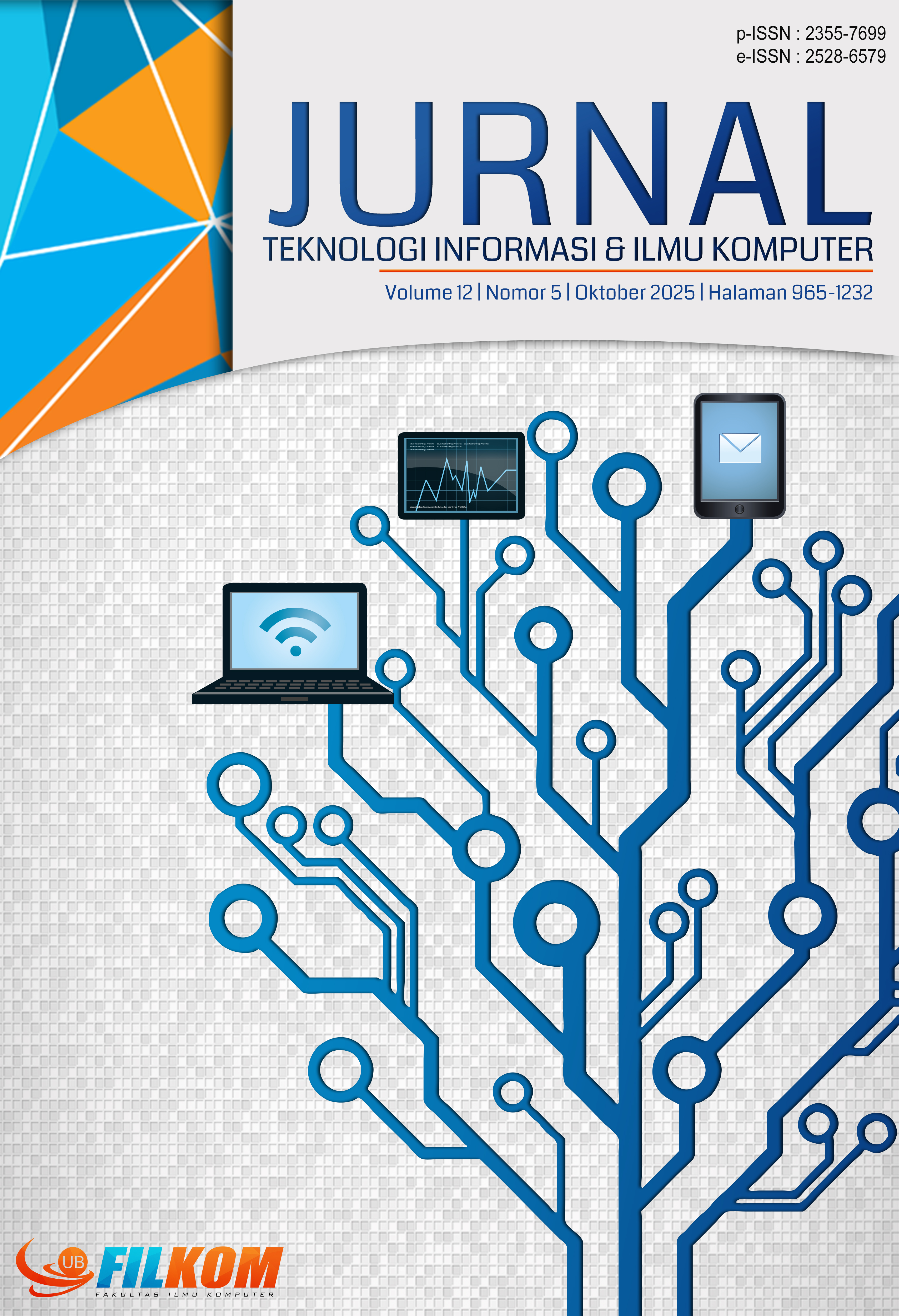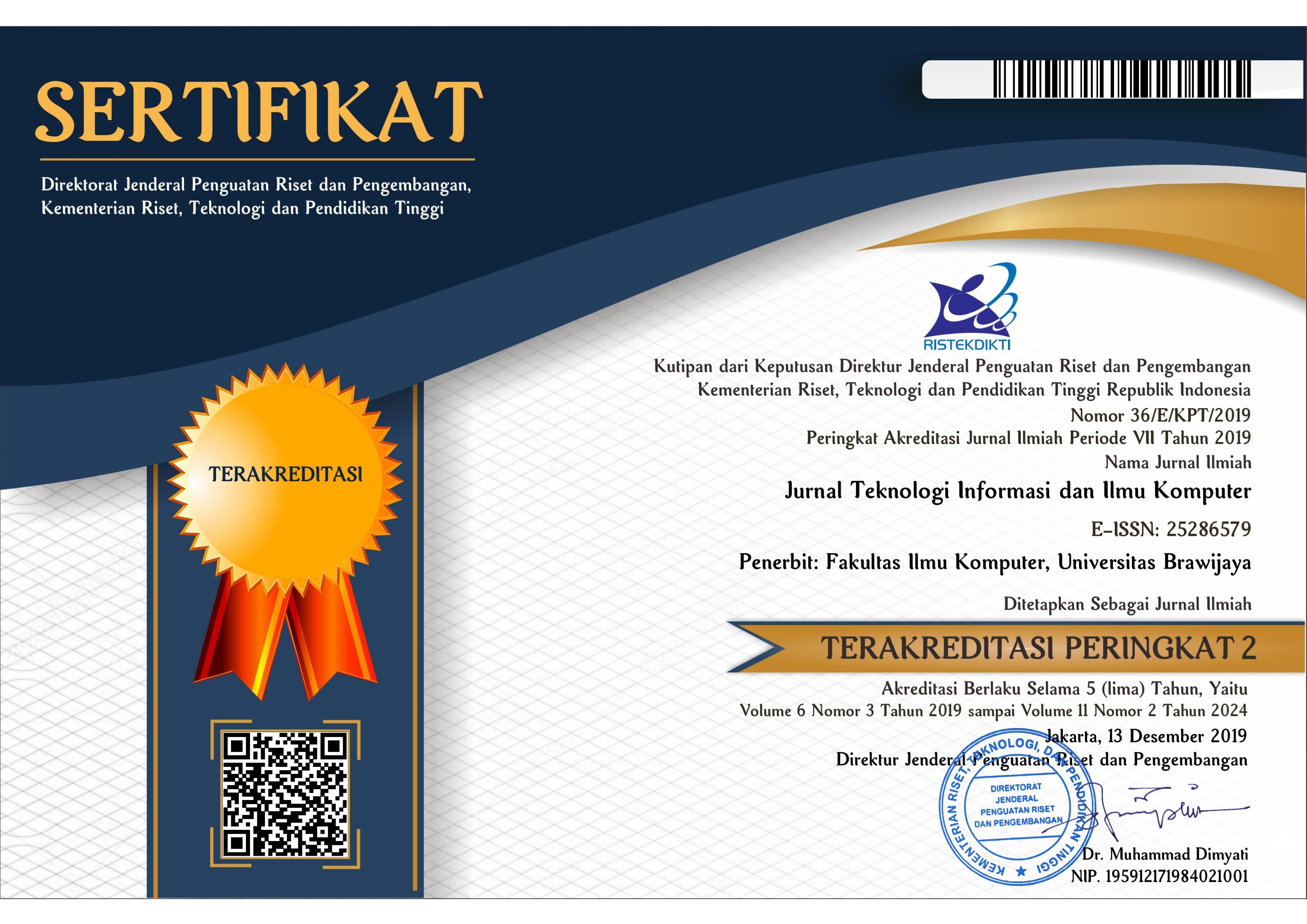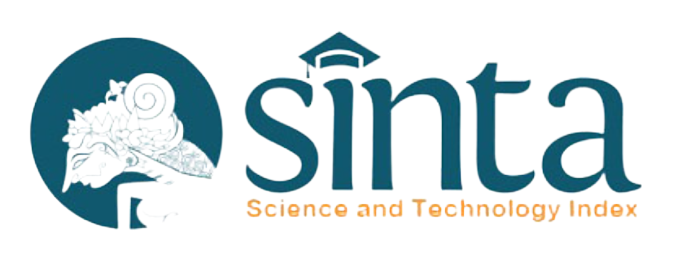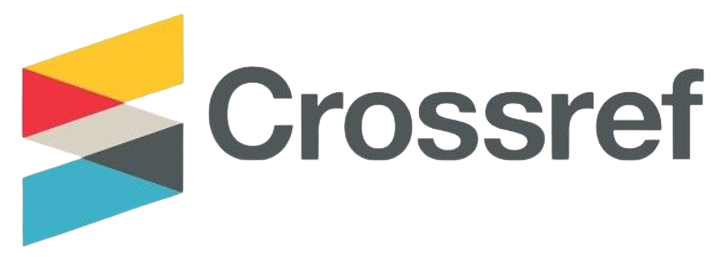Reversible Data Hiding pada Gambar Digital dengan Sistem Otentikasi Terintegrasi
DOI:
https://doi.org/10.25126/jtiik.2025125Kata Kunci:
Steganography, RDH, PIN, PSNR, SSIMAbstrak
Reversible Data Hiding (RDH) adalah salah satu metode yang efektif dalam steganografi, yang memungkinkan penyisipan informasi ke dalam media digital, seperti gambar, dengan kemampuan untuk memulihkan data asli sepenuhnya setelah informasi yang disisipkan diekstraksi. Dengan mengkombinasikan menggunakan Personal Identification Number (PIN), pemilik karya seni dapat menjalankan proses penyisipan data, ekstraksi data, serta validasi gambar. PIN berfungsi sebagai mekanisme keamanan yang membatasi akses hanya kepada pemilik yang sah, sehingga memastikan perlindungan data serta mencegah manipulasi atau akses tidak sah terhadap karya digital. Selain itu, PIN digunakan untuk menentukan lokasi piksel yang dapat dimodifikasi pada gambar. Dataset yang digunakan adalah sepuluh gambar digital dengan ukuran piksel 720 x 1280 yang terdiri dari lima gambar digitar berwarna dan lima gambar hitam putih. Hasil pengujian sistem yang dibuat menunjukan sistem yang dibangun bekerja dengan baik dimana gambar hasil ekstraksi berkualitas baik dengan perbedaan kecil yang mungkin terlihat namun umumnya tidak mengganggu dengan nilai PSNR gambar berwarna adalah 38.076 db dan rata-rata PSNR gambar hitam putih 50.58. Sedangkan untuk pengujian SSIM nilai pengujian rata-rata 0.98 yang berarti secara struktural kedua gambar sama. Kapasitas penyimpanan informasi untuk gambar berwarna sebesar 13.05% sedangkan untuk gambar hitam putih sebesar 66.88%.
Abstract
Reversible Data Hiding (RDH) is an effective method in steganography that enables the embedding of information into digital media, such as images, with the ability to fully recover the original data once the embedded information has been extracted. By integrating the use of a Personal Identification Number (PIN), the owner of a work of art can carry out the processes of data embedding, data extraction, and image validation. The PIN functions as a security mechanism that restricts access exclusively to the rightful owner, thereby ensuring data protection and preventing unauthorized manipulation or access to the digital artwork. Additionally, the PIN is employed to identify specific pixel locations that can be altered within the image. The dataset used consists of ten digital images with a resolution of 720 x 1280 pixels, consisting of five colored images and five grayscale images The results of the system evaluation indicate that the extracted images maintain high quality, with minimal differences that are generally imperceptible where the PSNR for colored images is 38.076 dB, and the average PSNR for grayscale images is 50.58 dB. Meanwhile, SSIM testing yielded an average value of 0.98, signifying that the structural similarity between the original and extracted images is nearly identical. The information storage capacity for colored images was measured at 13.05%, whereas for grayscale images, it reached 66.88%.
Downloads
Referensi
AZIZ, F., AHMAD, T., MALIK, A.H., UDDIN, M.I., AHMAD, S. AND SHARAF, M., 2020. Reversible data hiding techniques with high message embedding capacity in images. PLOS ONE, 15(5). doi: 10.1371/journal.pone.0231602
CHATTERJEE, A., GHOSAL, S.K. AND SARKAR, R. (2020) ‘LSB based steganography with OCR: An intelligent amalgamation’, Multimedia Tools and Applications, 79(17–18), pp. 11747–11765. doi:10.1007/s11042-019-08472-6.
FREEPIK, 2025. digital art background and black white background | Freepik [online] Available at: <https://freepik.com/> [Accessed 10 February. 2025].
MALIK, A., SINGH, S. AND KUMAR, R., 2017. Recovery based high capacity reversible data hiding scheme using even-odd embedding. Multimedia Tools and Applications, 77(12), pp.15803–15827. doi: 10.1007/s11042-017-5156-1
MALIK, A., WANG, H., CHEN, T., YANG, T., KHAN, A. N., WU, H., ... & HU, Y. 2019. Reversible data hiding in homomorphically encrypted image using interpolation technique. Journal of Information Security and Applications, 48, 102374. doi:10.1016/j.jisa.2019.102374
P. PUTEAUX & W. PUECH. 2021. A Recursive Reversible Data Hiding in Encrypted Images Method With a Very High Payload," in IEEE Transactions on Multimedia, vol. 23, pp. 636-650, doi: 10.1109/TMM.2020.2985537.
PUTRANTO, M.F., BARMAWI, A.M. AND WAHYUDI, B.A., 2018. Permutation modification of reversible data hiding using difference histogram shifting in encrypted medical image. Procedia Computer Science, 135, pp.727–735. doi:10.1016/j.procs.2018.08.21
RAMDHANI, T., WAHYUDI, B.A. AND YUNANTO, P.E., 2022. Validation system with reversible data hiding in digital diplomas. 2022 10th International Conference on Information and Communication Technology (ICoICT), pp.124–128. doi: 10.1109/ICoICT55009.2022.9914852
S. ZHONG, Y. LU & X. XIONG, "Reversible Data Hiding Algorithm in Encrypted Domain Based on Image Interpolation," in IEEE Access, vol. 11, pp. 108281-108294, 2023, doi: 10.1109/ACCESS.2023.3321129.
SARA, U., AKTER, M. AND UDDIN, M.S., 2019. Image quality assessment through FSIM, SSIM, MSE and PSNR—a comparative study. Journal of Computer and Communications, 07(03), pp.8–18. doi:10.4236/jcc.2019.73002
SETIADI, D.R., 2020. PSNR vs SSIM: Imperceptibility Quality Assessment for Image Steganography. Multimedia Tools and Applications, 80(6), pp.8423–8444. doi: 10.1007/s11042-020-10035-z
SHI, Y.Q., LI, X., ZHANG, X., WU, H.-T. AND MA, B., 2016. Reversible data hiding: Advances in the past two decades. IEEE Access, 4, pp.3210–3237. doi: 10.1109/ACCESS.2016.2573308
WANG, V. AND WANG, D., 2021. The impact of the increasing popularity of digital art on the current job market for artists. Art and Design Review, 09(03), pp.242–253. doi: 10.4236/adr.2021.93019
YUAN, J., JIANG, Z., HUANG, P. AND CHEN, H., 2020. A reversible data hiding approach based on filter selection. 2020 International Conference on Intelligent Computing, Automation and Systems (ICICAS), 10, pp.424–428. doi:10.1109/ICICAS51530.2020.00094
XIONG, L., & DONG, D. 2019. Reversible data hiding in encrypted images with somewhat homomorphic encryption based on sorting block-level prediction-error expansion. Journal of Information Security and Applications, 47, 78-85. doi:10.1016/j.jisa.2019.04.005
ZHANG, H., SUN, S., & MENG, F. 2022. A high-capacity and reversible patient data hiding scheme for telemedicine. Biomedical Signal Processing and Control, 76, 103706. doi:10.1016/j.bspc.2022.103706
Unduhan
Diterbitkan
Terbitan
Bagian
Lisensi
Hak Cipta (c) 2025 Jurnal Teknologi Informasi dan Ilmu Komputer

Artikel ini berlisensiCreative Commons Attribution-ShareAlike 4.0 International License.

Artikel ini berlisensi Creative Common Attribution-ShareAlike 4.0 International (CC BY-SA 4.0)
Penulis yang menerbitkan di jurnal ini menyetujui ketentuan berikut:
- Penulis menyimpan hak cipta dan memberikan jurnal hak penerbitan pertama naskah secara simultan dengan lisensi di bawah Creative Common Attribution-ShareAlike 4.0 International (CC BY-SA 4.0) yang mengizinkan orang lain untuk berbagi pekerjaan dengan sebuah pernyataan kepenulisan pekerjaan dan penerbitan awal di jurnal ini.
- Penulis bisa memasukkan ke dalam penyusunan kontraktual tambahan terpisah untuk distribusi non ekslusif versi kaya terbitan jurnal (contoh: mempostingnya ke repositori institusional atau menerbitkannya dalam sebuah buku), dengan pengakuan penerbitan awalnya di jurnal ini.
- Penulis diizinkan dan didorong untuk mem-posting karya mereka online (contoh: di repositori institusional atau di website mereka) sebelum dan selama proses penyerahan, karena dapat mengarahkan ke pertukaran produktif, seperti halnya sitiran yang lebih awal dan lebih hebat dari karya yang diterbitkan. (Lihat Efek Akses Terbuka).














